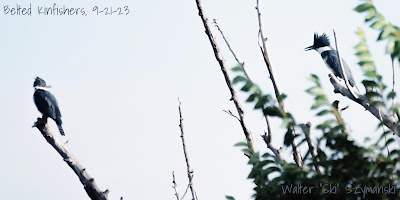These large-headed, short-necked, heavy-billed, robust-bodied, short-legged birds with spiked hairdos are a constant resident of our parts. And they are exceedingly difficult to capture a decent image of. At least that's been true of my attempts to do so over the years.
Such failures on my part notwithstanding, these are one of my most favorite birds because they never fail to cause my face to instantly contract into a smile the moment I hear or see them. And hearing their machine-gun rat-a-tat-tat call is virtually always how I become aware of their presence somewhere in my vicinity. If I'm lucky, I may then spot one off in the distance.
So why do I always smile when I hear them? Because an image of them with their over-sized head and spiked crest on a small body, like the male on the right in my photo here from yesterday, invariably reminds me of an cupcake-fueled 6-year-old whippersnapper with a pomaded tomahawk hairdo charging down a grocery store aisle while excitedly jabbering away a mile-a-minute about whatever it was that was so animating him at the time.
Such a vision, whether I happen upon it in a grocery store or while walking along Big Dry Creek, which is where I mostly hear and sometimes spot these energetic critters, never fails to cause me to smile.
Here's hoping one of these balls of energy, either the grocery store or fish-eating kind, soon brings a grin to your face too.
Cheers!
Walter "Ski" Szymanski




